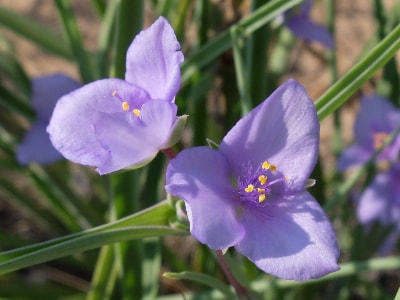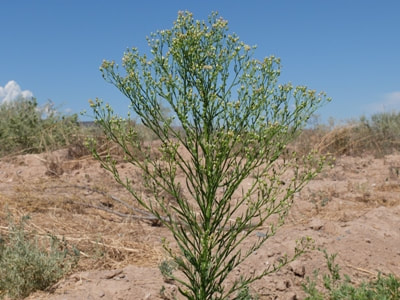|
Found in sandy areas, roadsides
Seen blooming in August by the road to Abiquiu Lake Puncture Vine is a low, creeping plant with many hairy branches that spread quickly forming a mat over three feet across. Leaves are divided into pairs of leaflets with silky hairs. Tiny yellow flowers, ½ inch across, produce a fruit that is hard and spiny and breaks into burs which look like a goat’s head. These sharp, strong spines can injure bare feet and the mouths of grazing animals and easily penetrate thin shoes and bicycle tires. It is considered noxious in Colorado and other states. It should not be put on the compost pile because seeds remain viable for 10 years. It is used as medicine by cultures around the world, including modern use as a dietary supplement to enhance athletic ability and for conditions such as chest pain, eczema, enlarged prostate, sexual disorders and infertility. However, there is no good scientific evidence to support these uses. Source. If you trying to identify a different flower then you can check what other flowers bloom this month. If you cannot identify a flower from the website send a photo and where you took it to [email protected]. Read online for tips.
0 Comments
Found in hot, sunny open areas
Seen blooming in August on the Madera Trail, Santa Fe National Forest Prairie Spiderwort grows to 20 inches tall with long, narrow, arching, grass-like leaves. Flowers grow in clusters and can be pink, purple or blue opening in the morning for a day. They are one to two inches across with three roundish petals and six stamens with long blue hairs topped by golden anthers. The cells of the stamen hairs of Prairie Spiderwort are normally colored blue, but when exposed to neutron radiation or other forms of ionizing radiation, the cells mutate and change color to pink. Thus the plant can be used as a bioassay for radiation. Source. There were bright pink flowers blooming on the trail. Native Americans ate the tender shoots of the Spiderwort as greens and used infusions of the root as a diuretic, an aphrodisiac, for internal injury and in a cut on the head 'to stop craziness.' Source. If you trying to identify a different flower then you can check what other flowers bloom this month. If you cannot identify a flower from the website send a photo and where you took it to [email protected]. Read online for tips. Found in disturbed soil
Seen blooming in August by CR 142, Abiquiu This common annual weed grows from two to seven feet tall, making it hard to miss. It is identifiable by its solitary, upright, leafy stem which ends in a many-branched flower head of numerous tiny white and yellow flowers. The leaves are long and narrow becoming smaller as they ascend the stem. If you look closely at the flowers you will see that they have rays, though the white ray petals are only about 1 mm long. Although rather uninteresting in appearance Horseweed has many traditional uses. Young leaves and seedlings are edible. Dried leaves can be used as a seasoning with a tarragon-like flavor. An essential oil is used to flavor candy, condiments and soda. Horseweed was boiled to make steam for sweat lodges, taken as a snuff to stimulate sneezing during the course of a cold and burned to create a smoke that warded off insects. It is said to be a very effective treatment for bleeding hemorrhoids. A tea from the leaves was used to treat dysentery and a tea from the boiled root for menstrual issues. Horseweed has also been called Fleabane because the leaves put in pet’s beds help to get rid of fleas. Source. If you are trying to identify a different flower, then you can check what other flowers bloom this month. If you cannot identify a flower from the website send a photo and where you took it to [email protected]. Read online for tips. Found in sandy soils, grasslands, woodlands
Seen blooming in August in Plaza Blanca, Abiquiu Nodding Buckwheat grows from 2 to 20 inches high, usually about 10 inches, with many delicate, airy branches. It is quite common but easily bypassed because it has such tiny flowers. The leaves are roundish and low on the stem. The tiny flowers have white to pinkish ruffled petals and dangle from slender stalks that are less than 1 inch long. The whole plant turns maroon with age. Seeds were gathered by the Navajo (Diné) people, pounded into a meal, and eaten dry or made into a porridge. It was also used to treat rashes, kidney disease, and ant bites. Source. If you trying to identify a different flower then you can check what other flowers bloom this month. If you cannot identify a flower from the website send a photo and where you took it to [email protected]. Read online for tips. |
AuthorI am Marilyn Phillips, a native of England, whose love of nature and the outdoors from childhood brought me by a circuitous route to Crested Butte, Colorado in 1993 and 16 years later to northern New Mexico. My exploration of the many trails in these areas, my interest in wildflowers and photography, and career in computer system design came together in this creation. If you have any corrections, comments or questions, please contact me by email. Archives
September 2025
Categoriescopyright © 2020
|






 RSS Feed
RSS Feed